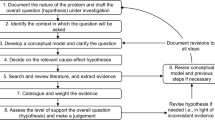Abstract
Sedimentation patterns in nine lake basins were examined where catchments were either clearcut, burned in recent history, or where there has been no recorded disturbance and the catchments consist of mature forests. Pronounced declines in sedimentation rates were observed in eight of eleven cores after 1980, in reference, clearcut, and burn lakes. The degree of change was positively correlated with the drainage ratio (catchment area: lake area), but was unrelated to land use history. The decline in sedimentation rates after 1980 coincide with a 60% decrease in catchment runoff and precipitation measured over the same time interval at the nearby Experimental Lakes Area. These results indicate that climatic changes over the past 20 years have had a greater effect on catchment erosion than either clearcutting or fire.
Similar content being viewed by others
References
Bayley SE, Schindler DW, Beatty KG, Parker BR & Stainton MP (1992) Effects of multiple fires on nutrient yields from streams draining boreal forest and fen watersheds: Nitrogen and phosphorus. Can. J. Fish. Aq. Sci. 49: 584–596
Beaty KG (1994) Sediment transport in a small stream following two successive forest fires. Can. J. Fish. Aq. Sci. 51: 2723–2733
Binford MW, Kahl JS & Norton SA (1993) Interpretation of 210Pb profiles and verification of the CRS dating model in PIRLA project lake sediment cores. J. Paleolimnol. 9: 275–296
Blais JM & Kalff J (1993) Atmospheric loading of Zn, Cu, Ni, Cr, and Pb to lake sediments: The role of catchment, lake morphometry, and physico-chemical properties of the elements. Biogeochemistry 23: 1–22
Blais JM, Kalff J, Cornett RJ & Evans RD (1995) Evaluation of 210Pb dating in lake sediments using stable Pb, Ambrosia pollen, and 137Cs. J. Paleolimnol. 13: 169–178
Broeker WS & Peng T-H (1982) Tracers in the Sea. Eldigio Press, New York. 690 p
Brunskill GJ & Schindler DW (1971) Geography and bathymetry of selected lake basins in the Experimental Lakes Area (ELA), northwestern Ontario. J. Fish. Res. Bd. Can. 28: 277–294
Dearing JA (1991a) Erosion and land use. Ecol. Bull. 41: 283–292
Dearing JA (1991b) Lake sediment records of erosional processes. Hydrobiologia 214: 99–106
Dillon PJ & Evans RD (1982) Whole-lake lead burdens in sediments of lakes in southern Ontario, Canada. Hydrobiol. 91: 121–130
Douglas I (1969) Man, vegetation, and the sediment yield of rivers. Nature 215: 925–928
Edgington DN & Robbins JA (1976) Records of lead deposition in Lake Michigan sediments since 1800. Environ. Sci. Technol. 10: 266–274
Evans LJ (1989) Chemistry of metal retention by soils. Environ. Sci. Technol. 23: 1047–1056
Fleming G (1969) Design curves for suspended load estimation. Proc. Inst. Civ. Engrs. 43: 1–9
Flower RJ et al. (1989) Catchment disturbance inferred from paleolimnological studies of three contrasted sub-humid environments in Morocco. J. Paleolimnol. 1: 292–322
France RL (1997a) Macroinvertebrate colonization of woody debris in Canadian Shield lakes following riparian clearcutting. Conserv. Biol. In Press
France RL (1997b) Land-water linkages: Influences of riparian deforestation on lake thermocline depth and possible consequences for cold stenotherms. Can. J. Fish. Aq. Sci. In Press
France RL & Peters RH (1995) Predictive model of the effects on lake metabolism of decreased airborne litterfall through riparian deforestation. Conserv. Biol. 9: 1578–1586
France RL, Culbert H & Peters RH (1996) Decreased carbon and nutrient input to boreal lakes from particulate organic matter following riparian clear-cutting. Environ. Manag. 20: 579–583
Glew JR (1988) A portable extruding device for close interval sectioning of unconsolidated core samples. J. Paleolimnol. 1: 235–239
Glew JR (1991) Miniature gravity corer for recovering short sediment cores. J. Paleolimnol. 5: 285–287
O'Connor DJ (1988) Models of sorptive toxic substances in freshwater systems. II. Lakes and reservoirs. J. Environ. Eng. 114: 533–551
Oldfield F & Appleby PG (1984) Empirical testing of 210Pb-dating models for lake sediments. In: Haworth EY & Lund J (Eds) Lake Sediments and Environmental History (pp 93–124). University of Minnesota Press, Minneapolis
Omelchenko A et al. (1993 unpublished report) Freshwater Institute, Department of Fisheries and Oceans. Winnipeg, Manitoba
Peters DL, Buttle JM, Taylor CH & Lazerte BD (1995) Runoff production in a forested, shallow soil, Canadian Shield basin. Wat. Resour. Res. 31: 1291–1304
Robbins JA (1978) Geochemical and geophysical application of radioactive lead isotopes. In: Nriagu JO (Ed) Biogeochemistry of Lead (pp 285–393). Elsevier, Amsterdam
Rosman KJR, Chrisholm W, Boutron CF, Candelone JP & Gorlach U (1993) Isotopic evidence for the source of lead in Greenland snows since the late 1960s. Nature 362: 333–335
Rusak C (1991) Aquatic Effects Research Candidate Study Site Document. Ont. Min. Natur. Res., Thunder Bay, Ont. 106 p
Schindler DW, Newbury RW, Beatty KG, Prokopowich J, Ruszczynski T & Dalton JA (1980) Effects of a windstorm and forest fire on chemical losses from forested watersheds and on the quality of receiving streams. Can. J. Fish. Aq. Sci. 37: 328–334
Schindler DW, Bayley SE, Parker BR, Beatty KG, Cruikshank DR, Fee EJ, Schindler EU & Stainton MP (1996) The effects of climatic warming on the properties of boreal lakes and streams at the Experimental Lakes Area, northwestern Ontario. Limnol. Oceanogr. 41: 1004–1017
Schut PH, Evans RD & Scheider WA (1986) Variations in trace metal exports from small Canadian shield watersheds. Water, Air, Soil Pollut. 28: 225–237
Zoladeski CA & Maycock PF (1990) Dynamics of the boreal forest in northwestern Ontario. Amer. Midl. Natur. 124: 289–300
Zoltai SC (1961) Glacial history of part of northwestern Ontario. Proc. Geol. Ass. Can. 13: 61–83
Author information
Authors and Affiliations
Rights and permissions
About this article
Cite this article
Blais, J.M., France, R.L., Kimpe, L.E. et al. Climatic changes in northwestern Ontario have had a greater effect on erosion and sediment accumulation than logging and fire: Evidence from 210Pb chronology in lake sediments. Biogeochemistry 43, 235–252 (1998). https://doi.org/10.1023/A:1006065109925
Issue Date:
DOI: https://doi.org/10.1023/A:1006065109925




